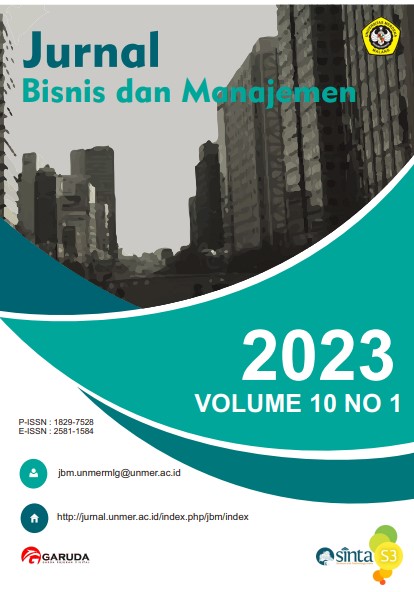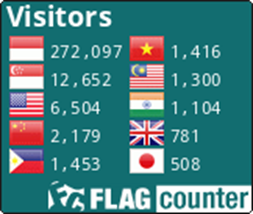Tourist Loyalty Based on Destination Image, Tourist Motivation and Tourist Satisfaction
DOI:
https://doi.org/10.26905/jbm.v10i1.8580Keywords:
Destination Image, Satisfaction, Loyalty, and MotivationAbstract
This study aims to analyze the relationship between destination image, motivation, tourist satisfaction, and tourist loyalty. Data was collected by questionnaire with a sample of 118 tourists who had visited Seribu Batu Songgo Langit tourist destination at least twice with the age of 15-39 years old. SEM analysis is used to test the hypotheses in the proposed conceptual model. Destination Image has a significant influence on Tourist Satisfaction and Tourist Loyalty; Tourist Motivation has a significant influence on Tourist Satisfaction and Tourist Loyalty; Tourist Satisfaction has a significant influence on Tourist Loyalty; Destination Image influence Tourist Loyalty through Tourist Satisfaction; Tourist Motivation influence Tourist Loyalty through Tourist Satisfaction. This study can be useful in the field of tourism/in the area of tourism, both natural and artificial tourism. Novelty/Originality of this study: The results of this study were explored using brand equity theoryDownloads
References
Aprilia Devi S; Pujiastuti, Eny Endah dan Hadi, Lukmono, 2019, Pengaruh Citra Destinasi, E WO terhadap Kepuasan Wisatawan dan Kepercayaan, ( Studi Pada Wisatawan yang berkunjung Tebing Breksi Daerah Istimewa Yogyakarta), DIALEKTIKA : Jurnal Ekonomi dan Ilmu Sosial, [S.l.], v. 4, n. 1, p. 85-95, apr. 2019. ISSN 2598-781X
Assaker, Guy and Rob Hallak. 2013. Moderating Effects of Tourists’ Novelty-Seeking Tendencies on Destination Image, Visitor Satisfaction, and Short- and Long-Term Revisit Intentions, Journal of Travel Research 52(5), 600– 613
Baker, D. a. and Crompton, J.L.. 2000. Quality, satisfaction and behavioral intentions. Annals of Tourism Research, 27(3), pp.785–804.
Beerli, A., and Martın, J. D. 2004. Factors influencing destination image. Annals of Tourism Research, 31(3), 657–681.
Backman, S. J., and Crompton, J. L. (1991). The usefulness of selected variables for predicting activity loyalty. Leisure Science, 13, 205–220.
Bigne, J.E., Sanchez, M.I. and Sanchez, J.. 2001. Tourism image, evaluation variables and after purchase behaviour: inter-relationship. Tourism Management, 22, pp.607–616.
Boo, S., Busser, J., and Baloglu, S. (2009). A model of customer-based brand equity and its application to multiple destinations. Tourism Management, 30, 219–231.
Cai, L.A., Wu, B.T. and Bai, B. (2003), “Destination image and loyaltyâ€, Tourism Review International,Vol. 7 Nos 3/4, pp. 153-162.
Cai, L.A., Wu, B. and Bai, B. (2004). Destination image and loyalty. Tourism Review International, 7(3–4), 153–162.
Castro, C.B.; MartÃn Armario E. and MartÃn Ruiz, D. 2007. The influence of market heterogeneity on the relationship between a destination’s image and tourists' future behaviour. Tourism Management, 28(1), pp.175–187.
Chen, C.-F., and Chen, F.-S. 2010. Experience quality, perceived value, satisfaction, and behavioral intentions for heritage tourists. Tourism Management, 31,29—35.
Chen, C.-F. and Phou, S.2013. A closer look at destination: Image, personality, relationship and loyalty. Tourism Management, 36, pp.269–278.
Chen, C.-F. and Tsai, D. (2007), “How destination image and evaluative factors affect behavioral intentions?â€, Tourism Management, Vol. 28 No. 4, pp. 1115-1122.
Chi, C.G.Q. and Qu, H. (2008), “Examining the structural relationships of destination image, tourist satisfaction and destination loyalty: an integrated approachâ€, Tourism Management, Vol. 29 No. 4,pp. 624-636
Chiu,Weisheng; Zeng, Shiheng and Tung Cheng , Philip Shao, 2016,The influence of destination image andtourist satisfaction on tourist loyalty:a case study of Chinese tourists in Korea, International Journal of Culture, Tourism and Hospitality Research, Vol. 10 Iss 2 pp. 223 – 234
Crandall, R. (1980). Motivation for leisure. Journal of Leisure Research 12(1), 45-54
Crompton, J. L. (1979). Motivations for pleasure vacation. Annals of Tourism Research,6,408–424.
Cronin, J.J., Brady, M.K. and Hult, G.T.M. 2000. Assessing the effects of quality, value, and customer satisfaction on consumer behavioral intentions in service environments. Journal of Retailing, 76(2), pp.193–218.
Ekinci, Y., Sirakaya-Turk, E., and Preciado, S. (2013). Symbolic consumption of tourism des tination brands. Journal of Business Research, 30(2), 10–15.
Fakeye, P.C., and Crompton, J.L. 1991. Image differences between prospective, first-time and repeat visitors to Lower Rio Grande Valley. Journal of Travel Research, 30(2), 10-16.
Hosany, S., and Prayag, G. (2013). Patterns of tourists' emotional responses, satisfaction, and intention to recommend. Journal of Business Research, 66(6), 730–737.
Huang, S., and Hsu, C. H. (2009). Effects of travelmotivation, past experience, perceived constraint, and attitude on revisit intention. Journal of Travel Research, 48(1), 29–44.
Hunt, H.K. (1983), Conceptualization and Measurement of Consumer Satisfaction and Dissatisfaction, Marketing Science Institute, Cambridge, MA.
Khuong MN and Ha HTT (2014) The Influences of Push and Pull Factors on the International Leisure Tourists' Return Intention to Ho Chi Minh City, Vietnam--A Mediation Analysis of Destination Satisfaction. International Journal of Trade, Economics and Finance 5(6): 490
Konecnik, M., and Gartner, W. C. (2007). Customer-based brand equity for a destination. Annals of Tourism Research, 34, 400–421.
Kotler, P., and Armstrong, G. (2004). Principles of marketing. (10 th ed), Upper Saddle River, Pearson Prentice Hall.
Kotler, P., Bowen, J., and Makens, J. (1996). Marketing for Hospitality and Tourism. New Jersey: Prentice Hall.
Kozak, M., and M. Rimmington. 2000. Tourist Satisfaction with Mallorca, Spain, as an Off-Season Holiday Destination. Journal of Travel Research, 38: 260-69.
Kozak, M. and Andreu, L. (2006). Progress in tourism marketing, Amsterdam: Elsevier.
Lau, A. L., and McKercher, B. (2004). Exploration versus acquisition: A comparison of ï¬rst-time and repeat visitors. Journal of Travel Research, 42(3), 279e285. https://doi.org/10.1177/0047287503257502
Lee, Tsung H. (2009). “A structural model to examine how destination image, attitude, and motivation affect the future behaviour of tourists.†Leisure Sciences, 31(3): 215-236
Mantyniemi, P. (2012). An analysis of seismic risk from a tourism point of view. Disasters, 36(3), 465–476.
Masa’deh, Nasseef, Alkoudary, Mansour, dan Aldarabah, 2017. “The Impact of Motivation for Attendance on Destination Loyalty via the Mediating Effect of Tourist Satisfactionâ€, International Journal of Business Administration Vol. 8, No. 4, 34-48.
Mawby, R.I., Brunt, P., & Hambly, Z. (2000). Fear of crime among British holidaymakers. British Journal of Criminology, 40(3), 468–479.
Meng, F., Tepanon, Y., and Uysal, M. (2008). Measuring tourist satisfaction by attribute and motivation: The case of a nature-based resort. Journal of Vacation Marketing, 14, 41–56.
Munhurrun, P. Ramseook; V.N. Seebaluck, and P. Naidoo.2015. Examining the structural relationships of destination image,perceived value, tourist satisfaction and loyalty: case of Mauritius, Procedia - Social and Behavioral Sciences, 175 ( 2015) 252 – 259
Newman, J. W., and Werbel, R. A. (1973). Multivariate analysis of brand loyalty for major household appliances. Journal of Marketing Research, 10(4), 404–409.
Oliver, R. L. (1997). Satisfaction: A behavioral perspective on the consumer. New York:McGraw-Hill.
Oliver, R.L. (1999), “Whence consumer loyalty?â€, Journal of Marketing, Vol. 63, pp. 33-44
Oppermann, M. (2000). Tourism destination loyalty. Journal of Travel Research, 39(1), 78–84.
Pearce, P. L. (1982). The social psychology of tourist behavior. Oxford: Pergamon.
Petrick, J. D. M., and Norman, W. (2001). An examination of the determinants of entertainment vacationers' intentions to visit. Journal of Travel Research, 40(1), 41–48.
Pike, S. 2004. Destination marketing organizations. Oxford, UK: Elsevier
Pike, S. (2010). Destination branding case study: Tracking brand equity for an emerging destination between 2003 and 2007. Journal of Hospitality & Tourism Research, 34(1), 124–139.
Pike, S., and Page, S. J. (2014). Destination marketing organizations and destinationmarketing: A narrative analysis of the literature. Tourism Management, 41,202 227. https://doi.org/10.1016/j.tourman.2013.09.009.
Prayag, G. (2009), “Tourists’ evaluations of destination image, satisfaction, and future behavioral intentions – the case of Mauritiusâ€, Journal of Travel & Tourism Marketing, Vol. 26 No. 8, pp. 836-853.
Prayag, G. and Ryan, C. (2012), “Antecedents of tourists’ loyalty to Mauritius: the role and influence of destination image, place attachment, personal involvement, and satisfactionâ€, Journal of Travel Research, Vol. 51 No. 3, pp. 342-356.
Pujiastuti, Eny Endah., Umar Nimran, Suharyono, dan Andriani K. 2017b. Study on Destination Image, Satisfaction, Trust, and Behavioral Intention. RJOAS. Vol. 1. No. 61.
Ryan, C. (1995), Researching Tourist Satisfaction: Issues, Concepts, Problems, Routledge, New
Ryan, C. (1995), Researching Tourist Satisfaction: Issues, Concepts, Problems, Routledge, New York,NY.
Santana, Arminda Almeida and Gil, 2018,Understanding tourism loyalty: Horizontal vs. destination loyalty, Tourism Management, Volume 65, Pages 245-255
Satoa, Shintaro; Kimb, , Hany; Buningc, Richard J. and Haradad, Munehiko, 2018, Adventure tourism motivation and destination loyalty: A comparison of decision and non-decision makers, Journal of Destination Marketing & Management, Volume 8,Pages 74-81
Spreng, R. and Dixon, A. (1992), ‘‘Alternative comparison standards in the formation of consumer satisfaction/dissatisfaction’’, in Leone, R. and Kumar, V. (Eds), Enhancing Knowledge Development in Marketing 1992 Educators Proceedings, American Marketing Association, Chicago, IL, pp. 85-91.
R. A. Spreng, S. B. MacKenzie, and R. W. Olshavsky, "A reexamination of the determinants of consumer satisfaction," The Journal of Marketing, vol. 60, pp. 15-32, 1996
Stepchenkova, Svetiana and Li, Xiang, 2014, Destination Image: Do Top of Mind Association pf Tourism Research 45:46-62
Tasci, A.D. and Gartner, W.C. (2007), “Destination image and its functional relationshipsâ€, Journal ofTravel Research, Vol. 45 No. 4, pp. 413-425.
Tellis, G. J. (1988). Advertising exposure, loyalty, and brand purchase: A two stage mode of choice. Journal of Marketing Research, 25(2), 134–144.
Toufaily, E., Ricard, L., and Perrien, J. (2013). Customer loyalty to a commercial website:Descriptive meta-analysis of the empirical literature and proposal of an integrative model. Journal of Business Research, 66, 1436–1447.
Woolf, H.B. et al. (Eds.). (1974). TheMerriam-Webster Dictionary. New York: Simon & Schuster, Inc.
Yoon, Y., and Uysal, M. (2005). An examination of the effects of motivation and satisfaction on destination loyalty: A structural model. Tourism Management, 26, 45–56.
Downloads
Published
How to Cite
Issue
Section
License
Authors who publish with this journal agree to the following terms:
(1) Copyright of the published articles will be transferred to the journal as the publisher of the manuscripts. Therefore, the author confirms that the copyright has been managed by the journal.
(2) Publisher of Jurnal Bisnis dan Manajemen is University of Merdeka Malang.
(3) The copyright follows Creative Commons Attribution–ShareAlike License (CC BY SA): This license allows to Share — copy and redistribute the material in any medium or format, Adapt — remix, transform, and build upon the material, for any purpose, even commercially.














